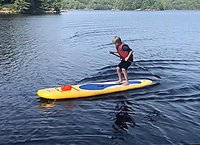Published in A & S News on August 4, 2022
by: Sean Bettam - A&S News
Stand up in a canoe and you’ll probably find yourself in the water before too long. Jump up and down on the upper edges of the sides of the canoe, and you’ll likely end up in the drink as well. But get the balance right and you’ll be able to move yourself along by as much as one metre per second, according to a study published in Physical Review Fluids examining gunwale bobbing.
In gunwale (pronounced “gunnel”) bobbing, a canoeist stands on the sides of the canoe — the gunwales — near the rear of the craft and jumps up and down, moving it forward by surfing the waves produced.
After an initial period of instability before finding its rhythm, the canoe achieves a cruising velocity which satisfies a balance between the thrust generated from pushing downwards into the surface of the waves and the resistance caused by drag. The technique also works on stand-up paddle boards.
“People have long enjoyed gunwale bobbing as something fun to do when out on the water, but no one has ever really explained how it works,” says Stephen Morris, a professor in the Department of Physics in the Faculty of Arts & Science and a co-author of the study describing the phenomenon. “By drawing on long-standing linear wave and oscillation theories, we’ve figured out how such balance can be sustained.”
Read the full story here:
https://www.artsci.utoronto.ca/news/creek-without-paddle-try-gunwale-bobbing-u-t-study
Article in Cottage Life Magazine:
https://cottagelife.com/outdoors/the-secret-every-paddler-should-know-the-science-of-gunwale-bobbing/

